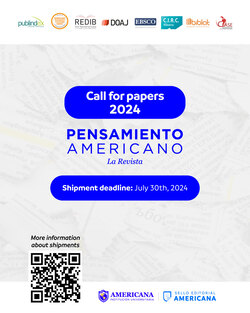A group communication analysis: one year experience with an interactive support therapeutic group
DOI:
https://doi.org/10.21803/pensam.v10i18.42Keywords:
Análisis de la comunicación; Ayuda interactiva; Grupo de comunicación; Psicología psicoeducativaAbstract
La ayuda interactiva grupal basada en la comunicacio?n y sustentada en la combinacio?n de los ejes de trabajo anali?tico, formativo y de ayuda social, esta? entendida como la voluntad y el intere?s en querer ayudar y ser ayudado, con el objetivo de explotar la capacidad propia para desplegar perspectivas de futuro resilientes acordes a los deseos propios. Este arti?culo presenta un modelo de implicacio?n pra?ctica que deriva de una investigacio?n empi?rica realizada con la metodologi?a observacional, que describe y analiza la evolucio?n de un grupo de tarea y relacio?n como caso u?nico, a lo largo de un an?o de tratamiento.
Palabras clave: Ana?lisis de la comunicacio?n, Ayuda interactiva, Grupo de comunicacio?n, Psicologi?a psico-educativa.
Abstract
The group interactive help based on communication and supported by the combination of analytical, educational and welfare-work axes, is understood as the willingness and interest in wanting to help and be helped, with the aim of exploiting one’s ability to deploy prospects commensurate with one’s own desires resilient future. is article presents a model of the practical implication that derives from empirical research with observational methodology, describes and analyzes the evolution of task and relationship group as a unique case, over one year of treatment.
Keywords: Communication analysis, Interactive support, Group communication, Psycho-educational psychology.
Resumo
A ajuda interativa em grupo fundamentada na comunicac?a?o e apoiado pela combinac?a?o dos eixos de trabalho anali?tico, formativo e apoio social, e? entendida como a vontade e interesse em querer ajudar e ser ajudado, a m de explorar a capacidade de implantar perspectivas proporcionais pro?prios desejos de um futuro resistente. Este artigo apresenta um modelo de implicac?a?o pra?tica derivada da pesquisa empi?rica com a metodologia de observac?a?o que descreve e analisa a evoluc?a?o de um grupo de tarefa e relacionamento como um caso u?nico ao longo de um ano de tratamento.
Palavras chaves: Ana?lise de comunicac?a?o, suporte interativo, comunicac?a?o em grupo, psicologia psico-educacional.
Downloads
References
Anguera, M.T. (1990). Metodología observa- cional. En J. Arnau Gras, M.T. Anguera, y J. Gomez Benito (Eds), Metodología de la investigación en ciencias del comportamiento. (pp.125-223). Universidad de Murcia: Campobell editores.
Anguera, M.T. (2000). Del registro narrativo al análisis cuantitativo: radiografía de la realidad perceptible. En ciencia y cultura en el siglo XXI. Estudios en homenaje a Josep Casajuana (pp.41-71). Barcelona: Real academia de doctores.
Apollinaire, 1898-1913. Alcools. Paris: Editions de la nouvelle revue française. Recuperado de BNF: http://gallica.bnf.fr/ ark:/12148/bpt6k1083760
Bakeman, R. & Gottman, J.M. (1989). Observación de la interacción: Introducción al análisis secuencial. Madrid: Morata.
Barberá, E. (1997). Marco conceptual e investigación de la motivación humana. Revista Electronica de Motivación y Emoción, 2 (1). Recuperado de http://www.reme. uji.es/articulos/texto.html
Burleson, B. & MCGeorge, E. (2004). Supportive Communication. En Knapp, M. & Daly (Eds.), Handbook of Interpersonal Communication, 3o ed. (pp.374-413). ousand Oak: sage publications.
Burlingame, G., Kapetanovic, S., & Ross, S.(2005). Group Pshychotherapy. En S.Wheelan (Ed.), e Handbook of group research and practice (pp.387-406). ousand Oaks: Sage.
Carkhu , R. (2000). e art of helping in the 21 century. MA: Human Ressourse Development Press.
Etkin, A., Phil, M. Pittinger, C. et al. (2005). Toward a neurobiology of psychotherapy: Basic science and clinical applications, J. of Neuropsychiatry & Clin. Neuroscience, 17, 145-158.
Frey y Sunwolf, (2005). e Communication Perspective on Group Life. En S.Wheelan (Ed), e Handbook of group research and practice (pp.159-184). ousand Oak, CA: Sage.
Guimón, J. (2003). Manual de terapias de grupo. Madrid: Biblioteca nueva.
Hayashi, R. (1991). Floor structure of English and Japanese Conversation. J. of pragmatics, 16, (1-30).
Hirokawa, R.Y. (1988). Group communication research: Considerations for the use of interaction analysis. In C.H. Tardy (Ed.), A handbook for the study of human communication: Methods and instruments for observing, measuring, and assessing communication processes (pp. 229-245). Norwood New jersey: Ablex
Kandel, E. R. (2007). En busca de la memoria. Madrid: Katz editores.
Knapp, M.L. & Daly, A. (2002). Handbook of interpersonal communication. London: Sage.
Lacan, J. (1966). Fonction et champ de la parole et du lenguaje (cap). Ecrits. Paris: Seuil.
Leahey, T.H. (2001). Historia de la psicología, 4o Edición. Madrid: Prentice Hall.
Magnusson, M. (2006). Structure and communication in interaction. En G. Riva, M.T. Anguera, B.K. Wiederhold and F. Mantovani (Eds.), From Communication to Presence: Cognition, Emotions, and Culture towards the Ultimate Communicative Experience. (pp. 127-145). IOS Press, Amsterdam.
Merleau-Ponty, M. (1964). Le visible et l’invisible. Paris: Gallimard.
Miller, J.A., 2006. “Introducción a la clínica lacaniana. Conferencias en España”, Barcelona: RBA.
Miller, J.A. (2015). Lo real de la experiencia analítica. Freudiana, 75, 7-21.
Nitsun, M. (1989). Linking the individual and the Group, Group Analysis, 22, 249-260.
Ornstein, R. & Sobel, D. (1999). e healing brain: a scientic reader. CA: Malor.
Pichon-Riviere, H. (1975). Teoría del vínculo. Barcelona: Nueva Visión.
Pincus, D. & Guastello, S.J. (2005), Nonlinear dynamics & interpersonal correlates of verbal turn-talking patterns in a group therapy session. Small Group Research, 36, (6) 635- 677.
Plummer, K. (1989). Los documentos perso- nales: Introducción a los problemas y la bibliografia del método humanista. Madrid: Siglo 21.
Porcel y Guardia (2007). Revisión general del concepto de atención. Instituto de altos estudios universitarios. Acceso http: www.iaeu.es
Poyatos, F. (1994). La Comunicación no verbal I, Cultura, lenguaje y conversación.Madrid: ISTMO.
Rojas, L y Fuster, V. (2008). Corazón y mente. Barcelona: Planeta.
Roustan, M. (2006). Estudio temático de relatos personales. Créditos de investigación DEA, en el doctorado de en psicología de la comunicación.
Barcelona: universidad Autónoma, dep. de psicología básica, evolutiva y de la educación.
Roustan, M. (2008). Cáncer: cuando habla el cuerpo. Barcelona: Publi-Corinti.
Roustan, M. (2010). Estudio observacional de ayuda interactiva en el postratamiento de cáncer de mama: reuniones GAFA. Tesis doctoral. Barcelona: Universidad Autónoma de Barcelona, Facultad de Psicología, Departamento de Psicología básica, evolutiva y de la educación.
Roustan, M, Izquierdo, C. Anguera, M.T. (2013). Sequential analysis of an interactive peer support group. Psicothema, 25, 3, 396-401.
Sartre, J.P. (1938). La nausée. Paris: Gallimard. Sackett, 1980. Sackett, G.P. (1980). Lag sequential analysis as a data reduction technique in social interaction research. In D.B. Sawin, R.C. Hawkins, L.O. Warker, y J.H. Penticuf (Eds.), Exceptional infant: Psychosocial risks in infant-environment transactions, vol.4 (pp.300-349). NY: Brunner-Mazel.
Searles, H., 2003. L’E ort pour rendre l’autre fou. Paris: Gallimard.
Yalom, I. (2000). Psicoterapia existencial y terapia de grupo. Barcelona: Paidós.
Yalom, I. y Greaves, C. (1977). Terapia de grupo con pacientes cancerosos y enfermos Terminales. En H. Kaplan y B. Sadock (Eds.), Terapia de grupo, 3a edición. Madrid: Editorial médica panamericana. Winnicott, D. (1998). Los bebés y sus madres. Barcelona: Paidós.
Winnicott, D. (1963). El desarrollo de la capacidad de preocuparse por el otro. Trabajo presentado ante la sociedad psicoanalítica de Topeka y publicado en 1963.
Downloads
Published
Issue
Section
License
Copyright (c) 2017 Pensamiento Americano

This work is licensed under a Creative Commons Attribution-NonCommercial-NoDerivatives 4.0 International License.
The author or authors of an article accepted for publication in the Journal Pensamiento Americano will transfer all of the patrimonial rights to the American University Corporation free of charge, within which are included: the right to edit, publish, reproduce and distribute both print media as digital, in addition to include in article in international indexes and / or databases, likewise, the Editorial Seal is authorized to use the images, tables and / or any graphic material presented in the article for the design of covers or posters from the same magazine. By assuming the patrimonial rights of the article, it may not be partially or totally reproduced in any printed or digital media without its express permission.
AUTHORITY ASPECTS
For the Pensamiento Americano Journal, all the authors of an article have made substantial contributions to the research and the manuscript, and they share the responsibility when the article presents errors, fraud in some way or violations of copyright.
After submitting an article, the journal does not accept the addition, deletion or change in the order of the authors, in addition we reserve the right to release the article when it has been submitted to the journal and under no circumstances will American Thought accept the article. withdrawal of an article during any phase of the editorial process






